We all know the feeling when your baby just won't stop crying. You've tried everything, but nothing seems to work and you're at your wit's end. When the wahhs start getting your baby (and you) down, it’s time to take a new approach when soothing those tears.
Why do babies cry?
First, it's important to understand why your baby might be crying. For now, crying is their only means of communication, so there are a lot of reasons why they cry. The more time you spend with your baby, the more you'll understand what each cry means. Here are some of the main reasons your baby might be crying with an age-by-age guide and the things you can do to help your baby and soothe them, with expert advice and tips from real mums.
Here is our guide for how best to stop your baby crying, split into each age group.
For 0-3 Months:

Is it a hungry cry? - Every baby will have his own set of cries and you’ll get used to understanding them. ‘Most babies who are hungry have a “wah wah” sound to their cry and there’s often a cough,’ says Tinies maternity nurse Tess Rendell. ‘Some of the time, he’ll even stop crying to cough.’
Ignore the clock - A baby who feeds every three hours will sometimes want to eat after only one or two hours. ‘Don’t think, “He can’t be hungry, it’s only been an hour”. Just go with it,’ says baby expert Sarah Ockwell-Smith. At this age, his first need is food, so feed on demandto keep him happy.
Check him over - Is he too hot or cold? Is something digging in too tightly or scratching him, such as straps, zips or buttons? Also look out for hair tourniquet syndrome, which is when a loose hair (usually yours) is wrapped around your baby’s toe or finger. Although unusual, it can be painful and lead to your baby’s finger looking red and swollen. If this happens, take him to your GP.
Use your hands - If your baby is crying fiercely in the late afternoon and evening and draws his legs up to his chest, it could be colic. Try massaging his tummy in a clockwise direction, gently stroking his legs and arms, and tracing tiny circles on his palms and the soles of his feet.
Try a new burp solution - A gassy baby will be grouchy, so ease trapped wind by resting him on his tummy. The Tiger In The Tree baby yoga position can help. Cradle him along the length of your forearm with his head near the crook of your elbow, and his legs dangling down either side of your arm.
For 3-12 Months:

Learn to decode cries - Pain and discomfort cries come in different patterns. ‘If your baby bumps his head, say, the pain is intense, then it disappears. But, when he has wind, the pain comes in waves,’ says Tess. Your baby’s cries will replicate this pattern. He’ll let out a shriek, then cry fiercely if he’s hurt, but a child with wind might have a rolling cry that comes and goes with the pain.
Get on the ball - Settle your baby in a sling or baby carrier, then gently bounce up and down on a fitness or birthing ball to soothe his cries. The up and down movement will remind him of when he was jiggled around in your stomach.
The shower trick - Remember the scene in the classic Three Men And A Baby when Ted Danson takes the baby in the shower to stop her crying? Not far off the mark. ‘The shower provides a rhythmic white noise that can help soothe your baby,’ says Sarah. ‘The warmth and closeness as you hold him skin-to-skin is comforting – just make sure you shelter him from the direct flow of water.’
Be a copycat - Try shushing your baby at a similar volume to his cries. ‘When the wails decrease in volume, follow his lead,’ says Tess. By copying your baby, he’ll feel understood, which should help calm him.
White out his world - Hang a white sheet over the hood of your baby’s pram – the plain background will calm him if he’s over-stimulated and needs to rest. ‘Holding him over your shoulder and standing with your back to a white wall has the same effect,’ says Rosie Harper, from Worcester, who’s mum to Josh, five months.
Use ‘la pause’ - This is what French mums call the couple of minutes you wait before going to your crying baby at night – if you’re lucky, he’ll settle himself. ‘Between four and six months, your little one can learn to self-soothe,’ says Megan Faure, author of The Babysense Secret (£12.99, DK). ‘When your baby comes into a light sleep state, he may cry out. It’s not because he needs you, but because he’s alert.’
Do a disappearing act - At around 8-10 months, babies quite often develop separation anxiety and cry when you leave the room. He needs to learn you exist even when he can’t see you. ‘Playing peek-a-boo helps,’ says Megan. ‘Hide behind a muslin and pop your head around.’
For 12-18 Months:

Find your car song - When he’s not sleeping well, your baby probably won’t be a fan of long car journeys. ‘I sing my daughter’s favourite song over and over. It’s exhausting, but seems to stop her wailing,’ says Catherine Graham, from Manchester, who’s mum to Lola, one.
Banish nightmares - If your little one screams in the night, but still looks asleep when you go to him, it could be night terrors. ‘These cries are distressing, but your baby won’t remember them,’ says Megan. ‘They’re usually linked to over-stimulation and tiredness, so let your toddler nap during the day.’
Keep a lid on it - Your baby will be so in tune with your emotions now, he’ll pick up on tension. ‘If you’re stressed, he will cry harder,’ says Tess. Try to watch where and when you have a row with your partner – your baby’s bedtime isn’t ideal.
Make a Box of Tricks - If your tot’s toys are always out, they’ll lose some of their magic. Keep a few treasures back so you can use them as a distraction. ‘I keep a bag of toys hidden away, so that when my son is on the verge of a meltdown, I can whip one out,’ says Beth Gronig, 32, from London, who’s mum to Oscar, 20 months.
Accept his feelings - At around 18 months, your toddler will often cry due to frustration, as his verbal abilities lag behind his understanding – he knows what you’re saying, but can’t explain what he wants. Acknowledge his frustration. Say, ‘I understand that you want me to buy a toy’. Then give a boundary, such as, ‘You can have one when we get home.’
When to be concerned

Distinguishing a nasty bout of colic from an actual bug isn’t always easy, but here’s what to look out for…
-
Listen: There are subtle differences in the sound of a baby’s cry when he’s ill. High-pitched cries, shrieks, snuffles and wheezing are all signs of illness. If he’s got a temperature, his breathing may be more rapid. Call NHS Direct (111 or 0845 4647, depending on your area, see nhsdirect.uk) if you’re worried.
-
Look: If your baby’s unwell, he may also have other symptoms to look out for. Check his nappy – either for diarrhoea or if he hasn’t produced a wet one recently. If your baby seems unresponsive, floppy, listless and/or has a rash on his body, take him straight to hospital.
-
Touch: Feel your baby’s forehead with the back of your hand, as it’s cooler than your palm. Then compare it with your own forehead, to see if he has a fever. If you think he does, double-check using a thermometer. Contact your doctor if his temperature reaches 38°C or over.
What if my baby isn't crying?
You might think having a quiet baby that doesn't really cry is a good thing, but if your baby doesn't seem to be responding to changes in their environment and sensory influences, your baby needs help and you should call your pediatrician.
